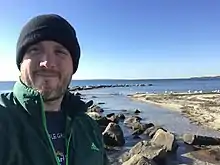Peter H. Barry
Peter H. Barry is an American geochemist who is an associate scientist in the marine chemistry and geochemistry department at the Woods Hole Oceanographic Institution.[1] He uses noble gases and stable isotopes to understand the volatile history and chemical evolution of Earth,[2] including the dynamic processes of subduction, mantle convection and surface volcanism,[3] which control the redistribution of chemical constituents between the crust and mantle reservoirs.[4] Barry’s main research focus has been on high-temperature geochemistry,[5][4] crust-mantle interactions[6] and the behavior of volatile fluids in the lithosphere.[7] He also studies crustal systems, the origin of high helium deposits,[8] including hydrocarbon formation and transport mechanisms.[9]
Peter H. Barry | |
|---|---|
 Barry in Cape Cod, MA, USA | |
| Alma mater | Scripps Institution of Oceanography |
| Scientific career | |
| Fields | Geochemistry |
| Institutions | Woods Hole Oceanographic Institution |
| Doctoral advisor | David Hilton |
| Website | https://www2.whoi.edu/staff/pbarry/pete-barry-2/ |
Barry earned his bachelor's degree in 2004 from SUNY Geneseo,[10] where he studied geology. He earned his master's degree in 2011 and PhD in 2012 from Scripps Institution of Oceanography. He was an NSF Postdoctoral Fellow[11] at University of Tennessee and continued his postdoctoral research at the University of Oxford during 2014–2018 before becoming an assistant scientist at the Woods Hole Oceanographic Institution in 2019. In 2018, he won the DCO Emerging Leader Award[12] from the Deep Carbon Observatory (DCO) and Alfred P. Sloan Foundation in part for leading the Biology Meet Subduction project.[13][14] The short science documentary produced within the framework of the project was awarded the first place price at the Goldschmidt Orbit Science Documentary Festival.[15]
Barry's major contributions to science[16] to date include explaining the End-Permian Extinction event, the distribution of major reservoirs of helium gas on Earth[8][17] and discovering new sinks of CO2 in subduction zones.[13][14] Several of his discoveries have been covered by international media outlets.[8][17][18][19][14][6]
References
- "Woods Hole Oceanographic Institution". www.whoi.edu/. Retrieved 2021-01-27.
- Bekaert, D.V.; Turner, S.J.; Broadley, M.W.; Barnes, J.D.; Halldórsson, S.A.; Labidi, J.; Wade, J.; Walowski, K.J.; Barry, P.H. (2021-05-30). "Subduction-Driven Volatile Recycling: A Global Mass Balance". Annual Review of Earth and Planetary Sciences. 49 (1): annurev–earth–071620-055024. Bibcode:2021AREPS..49...37B. doi:10.1146/annurev-earth-071620-055024. ISSN 0084-6597. S2CID 225143459.
- Broadley, Michael W.; Barry, Peter H.; Ballentine, Chris J.; Taylor, Lawrence A.; Burgess, Ray (September 2018). "End-Permian extinction amplified by plume-induced release of recycled lithospheric volatiles". Nature Geoscience. 11 (9): 682–687. Bibcode:2018NatGe..11..682B. doi:10.1038/s41561-018-0215-4. ISSN 1752-0908. S2CID 133833819.
- Barry, P. H.; Hilton, D. R.; Füri, E.; Halldórsson, S. A.; Grönvold, K. (2014-06-01). "Carbon isotope and abundance systematics of Icelandic geothermal gases, fluids and subglacial basalts with implications for mantle plume-related CO2 fluxes". Geochimica et Cosmochimica Acta. 134: 74–99. Bibcode:2014GeCoA.134...74B. doi:10.1016/j.gca.2014.02.038. ISSN 0016-7037.
- Barry, P. H.; Hilton, D. R.; Fischer, T. P.; de Moor, J. M.; Mangasini, F.; Ramirez, C. (2013-02-15). "Helium and carbon isotope systematics of cold "mazuku" CO2 vents and hydrothermal gases and fluids from Rungwe Volcanic Province, southern Tanzania". Chemical Geology. Frontiers in Gas Geochemistry. 339: 141–156. Bibcode:2013ChGeo.339..141B. doi:10.1016/j.chemgeo.2012.07.003. ISSN 0009-2541.
- "Geologists uncover new clues about largest mass extinction ever". ScienceDaily. Retrieved 2021-01-27.
- Howarth, Geoffrey H.; Barry, Peter H.; Pernet-Fisher, John F.; Baziotis, Ioannis P.; Pokhilenko, Nikolay P.; Pokhilenko, Lyudmila N.; Bodnar, Robert J.; Taylor, Lawrence A.; Agashev, Aleksey M. (2014-01-01). "Superplume metasomatism: Evidence from Siberian mantle xenoliths". Lithos. 184–187: 209–224. Bibcode:2014Litho.184..209H. doi:10.1016/j.lithos.2013.09.006. ISSN 0024-4937.
- "We're Running Out of Helium, and Two Geologists Might Have a Fix". Bloomberg.com. 2019-08-28. Retrieved 2021-01-27.
- Barry, P. H.; Lawson, M.; Meurer, W. P.; Warr, O.; Mabry, J. C.; Byrne, D. J.; Ballentine, C. J. (2016-12-01). "Noble gases solubility models of hydrocarbon charge mechanism in the Sleipner Vest gas field". Geochimica et Cosmochimica Acta. 194: 291–309. Bibcode:2016GeCoA.194..291B. doi:10.1016/j.gca.2016.08.021. ISSN 0016-7037. S2CID 133295339.
- Geneseo Newsletter (2013). "Geneseo Geology Newsletter" (PDF). Retrieved 27 January 2021.
- "NSF Award Search: Award#1144559 – A PETROLOGICAL AND NITROGEN ISOTOPE STUDY OF CRUSTAL RECYCLING THROUGH TIME". www.nsf.gov. Retrieved 2021-01-27.
- "2018 DCO Emerging Leader Award Recipients Selected | Deep Carbon Observatory". deepcarbon.net. Retrieved 2021-01-27.
- Barry, P. H.; de Moor, J. M.; Giovannelli, D.; Schrenk, M.; Hummer, D. R.; Lopez, T.; Pratt, C. A.; Segura, Y. Alpízar; Battaglia, A.; Beaudry, P.; Bini, G. (April 2019). "Forearc carbon sink reduces long-term volatile recycling into the mantle". Nature. 568 (7753): 487–492. Bibcode:2019Natur.568..487B. doi:10.1038/s41586-019-1131-5. hdl:11511/30269. ISSN 1476-4687. PMID 31019327. S2CID 129945956.
- "Microbes may act as gatekeepers of Earth's Deep Carbon". ScienceDaily. Retrieved 2021-01-27.
- "DCO film wins top prize at Goldschmidt Film Festival | Deep Carbon Observatory". deepcarbon.net. Retrieved 2021-01-27.
- "Peter H. Barry". Google Scholar. Retrieved 2021-01-27.
- "Helium discovery a 'game-changer'". BBC News. BBC. 2016-06-28. Retrieved 2021-01-27.
- "New geochemical tool reveals origin of Earth's nitrogen: Novel analysis method may also be useful for monitoring volcanic activity". ScienceDaily. Retrieved 2021-01-27.
- Fountain, Henry (2016-06-28). "Scientists Devise New Way to Find an Elusive Element: Helium". The New York Times. ISSN 0362-4331. Retrieved 2021-01-27.